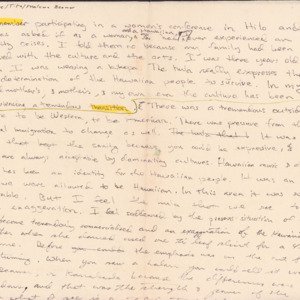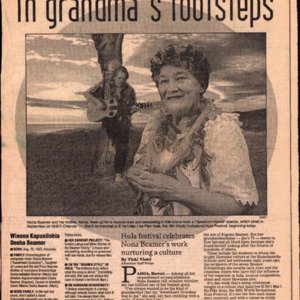Winona Beamer
Title
Winona Beamer
Description
Winona Beamer
Nona Beamer is the daughter of Louise Beamer and is the mother of Keola and Kapono Beamer. She currently serves on the Native Hawaiian Study Commission and is a member of the faculty of the Kamehameha Schools.
The house in Hilo is right on the banks of the Wailuku River. “Sweetheart Grandma” always had stalks of bamboo in the corners of the house and there was a gentle breeze, a nice flow of air always drifting through the house. I was mesmerized by the feeling of this breeze, how soothing it was as it mixed with the sounds of the river and the rustling of the bamboo.
The hula for me was a family obligation. I’m not sure if I really liked it when I began. My earliest recollection of dancing was at the Volcano on the Big Island. It was cold and there was gravel on the ground and I was very upset with my grandmother for making me dance.
My first kumu were my great-grandmother Isabella Desha and my grandmother Helen Desha Beamer whom we called “Sweetheart Grandma.” She was a great inspiration to me. She was always trying to train us to have the right feelings within ourselves so that we could experience the calmness that was all around us. When we walked into a room we had to walk as if our feet weren’t touching the mat. If she heard your feet scuffling the mat you would have to go out and come in again. Sometimes she would train us outside and the fragrance of the leaves and mangoes would be all around.
There was a hallway in the house where my grandfather had collected war implements from all over the world, and as a little girl it would frighten me to go through that hall and into the room where we danced. My grandmother would give each of us a tī leaf and talk about faith and hope and love. She would tell us the chants of Laka and she would tell them as if Laka was right there. While she talked she would tell us to feel the shape and the texture of the leaves and to put them up to our faces and feel their smoothness. She would talk of the mist over the mountains being the spirit of Laka and so everything that we do and say should be pleasing. So of course we would try our very best since we had a spirit watching over us.
In 1927 my mother opened a studio on the second floor of the old Kodak building in Waikiki and in 1934 I began to teach for her. My mother had a tremendous influence on me because she is a master teacher and she gave me a firm foundation in every aspect of my education. I remember teaching Mary Pickford a hapa Haole number “To You Sweetheart Aloha” and holding her hands like my grandmother used to do. Her hands were so small and delicate almost as if there were no bones within them.
When I came to the Kamehameha Schools, I began working with underprivileged Hawaiian children at the Kakaʻako Mission School. I stayed with the program for four years because I just loved working with the children. They were more enthralled with my story-telling than anything else. They would be restless and so I would calm them down with a story. Their eyes would get big and it struck me that this was a way to convey the Hawaiian culture to them in a non- aggressive, natural way. Maybe I could have made more money in other pursuits but I never considered anything else but teaching. Each individual student is so precious and so important. It’s that feeling I get when there’s a little bit of response in the eyes when you strike a little bit of interest in them. I think the biggest key to teaching is letting them know you care about them. After that a class session becomes an affair of the family.
Being Hawaiian at the Kamehameha Schools in the 1940’s was a hardship. It took us such a long time to gain a sense of our Hawaiianess. The great sadness of my life was trying to tell and teach people about the worthiness of the Hawaiian culture. It was so hard for people to believe. In 1949 almost out of desperation we decided to showcase the culture through lectures and performances at colleges and universities. We went on a fourteen-month tour of the Mainland and Mexico and we ended in New York City at the Carnegie Hall. We were trying to take the culture out of the sideshows and circuses and bring it to a level of dignity because you couldn’t even give it away in Hawai‘i.
The traditional kahiko to my understanding is the literature handed down by each generation from our forefathers. The kumu of today are trying their best but they are creating a new literature, a contemporary kahiko. I’d like to see standardization arise in the next ten years. We don’t need compartmentalization but some kind of control that would encourage quality. We need a clearinghouse where ideas and problems could be talked out and different degrees of competency established for hula teachers and students.
Nona Beamer is the daughter of Louise Beamer and is the mother of Keola and Kapono Beamer. She currently serves on the Native Hawaiian Study Commission and is a member of the faculty of the Kamehameha Schools.
The house in Hilo is right on the banks of the Wailuku River. “Sweetheart Grandma” always had stalks of bamboo in the corners of the house and there was a gentle breeze, a nice flow of air always drifting through the house. I was mesmerized by the feeling of this breeze, how soothing it was as it mixed with the sounds of the river and the rustling of the bamboo.
The hula for me was a family obligation. I’m not sure if I really liked it when I began. My earliest recollection of dancing was at the Volcano on the Big Island. It was cold and there was gravel on the ground and I was very upset with my grandmother for making me dance.
My first kumu were my great-grandmother Isabella Desha and my grandmother Helen Desha Beamer whom we called “Sweetheart Grandma.” She was a great inspiration to me. She was always trying to train us to have the right feelings within ourselves so that we could experience the calmness that was all around us. When we walked into a room we had to walk as if our feet weren’t touching the mat. If she heard your feet scuffling the mat you would have to go out and come in again. Sometimes she would train us outside and the fragrance of the leaves and mangoes would be all around.
There was a hallway in the house where my grandfather had collected war implements from all over the world, and as a little girl it would frighten me to go through that hall and into the room where we danced. My grandmother would give each of us a tī leaf and talk about faith and hope and love. She would tell us the chants of Laka and she would tell them as if Laka was right there. While she talked she would tell us to feel the shape and the texture of the leaves and to put them up to our faces and feel their smoothness. She would talk of the mist over the mountains being the spirit of Laka and so everything that we do and say should be pleasing. So of course we would try our very best since we had a spirit watching over us.
In 1927 my mother opened a studio on the second floor of the old Kodak building in Waikiki and in 1934 I began to teach for her. My mother had a tremendous influence on me because she is a master teacher and she gave me a firm foundation in every aspect of my education. I remember teaching Mary Pickford a hapa Haole number “To You Sweetheart Aloha” and holding her hands like my grandmother used to do. Her hands were so small and delicate almost as if there were no bones within them.
When I came to the Kamehameha Schools, I began working with underprivileged Hawaiian children at the Kakaʻako Mission School. I stayed with the program for four years because I just loved working with the children. They were more enthralled with my story-telling than anything else. They would be restless and so I would calm them down with a story. Their eyes would get big and it struck me that this was a way to convey the Hawaiian culture to them in a non- aggressive, natural way. Maybe I could have made more money in other pursuits but I never considered anything else but teaching. Each individual student is so precious and so important. It’s that feeling I get when there’s a little bit of response in the eyes when you strike a little bit of interest in them. I think the biggest key to teaching is letting them know you care about them. After that a class session becomes an affair of the family.
Being Hawaiian at the Kamehameha Schools in the 1940’s was a hardship. It took us such a long time to gain a sense of our Hawaiianess. The great sadness of my life was trying to tell and teach people about the worthiness of the Hawaiian culture. It was so hard for people to believe. In 1949 almost out of desperation we decided to showcase the culture through lectures and performances at colleges and universities. We went on a fourteen-month tour of the Mainland and Mexico and we ended in New York City at the Carnegie Hall. We were trying to take the culture out of the sideshows and circuses and bring it to a level of dignity because you couldn’t even give it away in Hawai‘i.
The traditional kahiko to my understanding is the literature handed down by each generation from our forefathers. The kumu of today are trying their best but they are creating a new literature, a contemporary kahiko. I’d like to see standardization arise in the next ten years. We don’t need compartmentalization but some kind of control that would encourage quality. We need a clearinghouse where ideas and problems could be talked out and different degrees of competency established for hula teachers and students.
Citation
“Winona Beamer,” Nā Kumu Hula Archive, accessed September 17, 2025, https://nakumuhula.org/archive/items/show/34.




